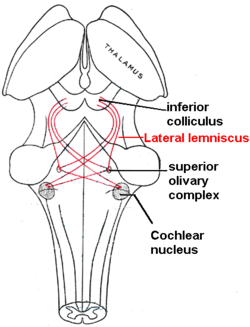Connections
- The lateral lemniscus is located where the cochlear nuclei and the pontine reticular formation crossover.
- Fibers leaving the intermediate nucleus of the lateral lemniscus (INLL), ventral nucleus of the lateral lemniscus (VNLL), and dorsal nucleus of the lateral lemniscus (DNLL) ascend to the inferior colliculus and rejoin the lateral lemniscus.
- The lateral lemniscus is the main auditory tract in the brainstem that connects the superior olivary complex with the inferior colliculus.
- The two lateral lemnisci communicate via the commissural fibers of Probst.
Nuclei of the lateral lemniscus
- The function of the complex of nuclei of the lateral lemniscus is not known.
- Cells in the nuclei of the lateral lemniscus have good temporal resolution compared to other cells higher than the cochlear nuclei.
- Cells in the nuclei of the lateral lemniscus are sensitive to both timing and amplitude changes in sound.
- The ventral nucleus of the lateral lemniscus is the most likely region involved in the acoustic startle reflex.
DNLL (Dorsal Nucleus of the Lateral Lemniscus)
- The cells of the DNLL respond best to bilateral inputs.
- DNLL cells have onset and complexity tuned sustained responses.
- The DNLL is primarily GABAergic.
- The DNLL projects bilaterally to the inferior colliculus and contralaterally to the DNLL.
- The DNLL has a prominent columnar organization in rats, with GABAergic and glycine-stained cells.
INLL (Intermediate Nucleus of the Lateral Lemniscus)
- The INLL has little spontaneous activity and broad tuning curves.
- The temporal responses of the INLL are significantly different from cells of the VNLL.
- The INLL is hypertrophied in rats, forming a prominent bulge on the surface of the brainstem.
- GAD, GABA, and glycine staining reveals distinct regions within the INLL.
- Most GABA+ cells in the INLL are gly+ as well.
VNLL (Ventral Nucleus of the Lateral Lemniscus)
- The strongest responses in the VNLL are elicited by sound in the contralateral ear.
- The VNLL is involved in temporary processing and decoding of amplitude-modulated sounds in the inferior colliculus.
- VNLL cells have little spontaneous activity and broad and moderately complex tuning curves.
- The VNLL is composed of two subdivisions in rats: ventral (columnar) and dorsal (non-columnar) regions.
- The VNLL contains glycine-positive and GABA+ neurons, with some cells containing both.
The lateral lemniscus is a tract of axons in the brainstem that carries information about sound from the cochlear nucleus to various brainstem nuclei and ultimately the contralateral inferior colliculus of the midbrain. Three distinct, primarily inhibitory, cellular groups are located interspersed within these fibers, and are thus named the nuclei of the lateral lemniscus.
| Lateral lemniscus | |
|---|---|
 Lateral lemniscus in red, as it connects the cochlear nucleus, superior olivary nucleus and the inferior colliculus. Seen from behind. | |
| Details | |
| Identifiers | |
| Latin | lemniscus lateralis |
| NeuroNames | 609 |
| NeuroLex ID | birnlex_976 |
| TA98 | A14.1.05.317 A14.1.08.670 A14.1.06.204 |
| TA2 | 5866 |
| FMA | 72502 |
| Anatomical terms of neuroanatomy | |